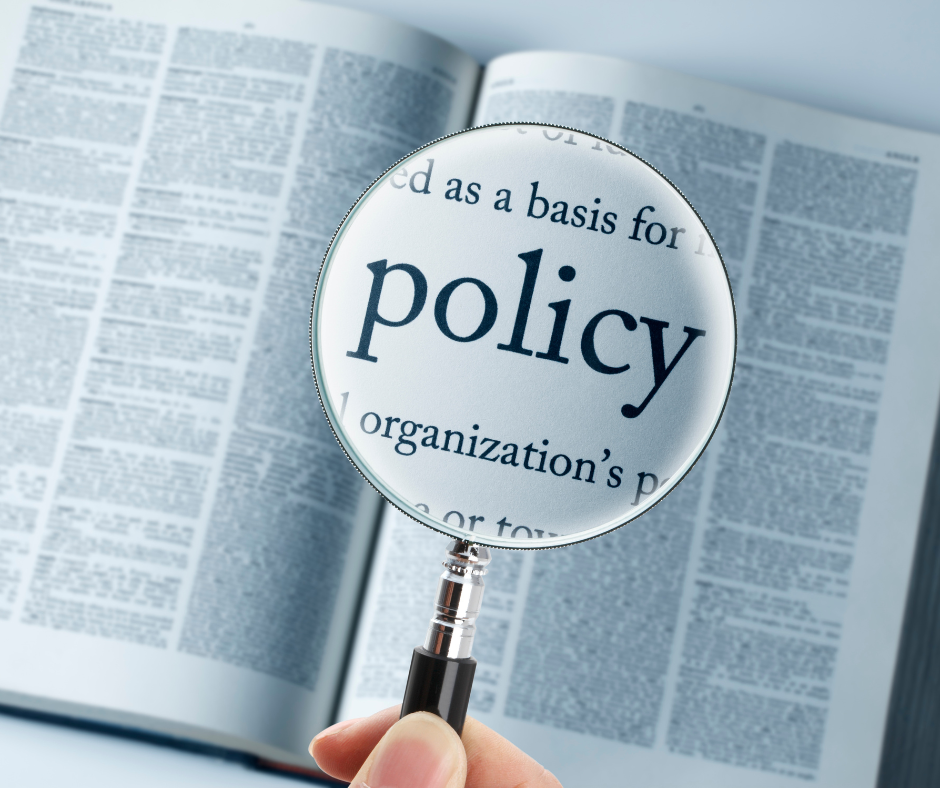
In today’s fast-paced and ever-evolving business landscape, understanding company policies definition is more critical than ever. As we navigate the challenges and opportunities presented in 2024, it is crucial for organizations to establish clear guidelines that reflect their values and protect both employees and employers. But how can we ensure that our policies remain relevant, effective, and legally compliant in this digital age? Let’s embark on a journey to explore the world of company policies, their purpose, and their impact on our rapidly changing workforce.
Key Takeaways
- Company policies are essential for providing guidance in managing personnel and business interests, creating a safe work environment, and protecting the organization from potential claims.
- Policies must have clarity, consistency & relevance while being regularly reviewed to remain applicable.
- Organizations should create company policies that cover areas such as Human Resources. Health & Safety, Financials, Code of Conduct/Ethics etc., address workplace conduct issues & legal considerations, adapt to the digital age needs & changing workforce requirements (e.g remote work), and promote diversity equity and inclusion initiatives.
Defining Company Policies
Before we dive deep into why we need company policies, let’s first start with defining what is a company policy. Company policies fundamentally serve as directives, assisting employers in managing aspects like health, safety, and responsibility of their personnel and their interaction with clients or customers. These policies are imperative for various reasons, such as serving as a cautionary measure for employees, delineating the repercussions of not adhering to regulations, including substance abuse policies, and protecting the organization’s business interests. Company policies and procedures address various aspects of the workplace, such as employee conduct, attendance, dress code, and privacy, among others.
An employee handbook serves as a consolidated source that conveys all corporate regulations in a readily available written form, ensuring that employees comprehend what is expected of them at all times. Besides helping employees understand the company’s policies, the handbook also supports management in policy enforcement and protects the organization against potential claims of bias or unfair treatment.
The Role of Company Policies
Company policies establish guidelines for addressing potential issues, and ensure that the organization’s vision and values are integrated into daily operations. An employee conduct policy establishes the expectations for employee behavior and is essential in promoting a safe, productive, and legally compliant work environment. These employee conduct policies not only establish the obligations and expectations each employee must fulfill as a requirement of employment, but they also set the tone for the workplace, fostering a professional atmosphere free from inappropriate behavior.
Company policies also offer a proactive measure to avoid legal complications, foster a healthy work environment, and ensure all employees are treated fairly. By implementing comprehensive policies, such as anti-discrimination, anti-harassment, and anti-bullying policies, organizations can effectively manage employee conduct and ensure that all workers are treated with respect and dignity.

Key Components of Company Policies
Effective company policies share several key components, such as clarity, consistency, and relevance to the workplace. These components are essential in ensuring that employees understand the policies and adhere to them, ultimately protecting the organization and its employees from potential hazards. To illustrate, a well-defined company policy on data privacy and security should clearly articulate the rules for handling sensitive information, provide guidelines for maintaining compliance with applicable laws and regulations, and address potential risks or threats to the organization’s physical and intellectual property.
Besides these crucial components, it’s necessary to routinely review and update company policies to keep them relevant to evolving laws, regulations, and business requirements. Keeping up with new developments and integrating them into current policies helps organizations reduce potential legal complications and uphold a secure and regulation-compliant work environment.
Let’s learn how to write a company policy!
Categories of Company Policies
Company policies can be broadly categorized into several areas, such as:
- Human Resources Policies
- Information Technology Policies
- Health and Safety Policies
- Financial Policies
- Code of Conduct/Ethics Policies
- Leave and Time-Off Policies
- Compliance Policies
- Dress Code and Appearance Policies
- Travel and Expense Policies
- Social Media and Communication Policies
Each of these categories addresses specific aspects of the workplace, ensuring that both employees and employers have clear guidelines to follow and maintain a harmonious work environment.
While policies in each category may differ among organizations, their common purpose is to offer a structure for tackling potential issues and fostering a safe, productive, and legally compliant work environment. By implementing policies that cover each of these categories, organizations can effectively manage the various aspects of their operations and protect their employees, customers, and business interests.

Workplace Conduct Policies
An employee conduct policy plays a crucial role in guiding employee behavior and maintaining a professional atmosphere. This policy encompasses a wide range of topics, such as:
- Dress code
- Proper use of company property
- Workplace safety procedures
- Harassment policies
- Policies related to computer and Internet usage
Policies discourage inappropriate behavior, ensuring a positive work environment for all employees.
They are designed to ensure that employees adhere to the company’s standards of conduct and provide clear guidelines for acceptable and unacceptable behavior in the workplace.
An essential aspect of workplace conduct policies is their focus on preventing discrimination, harassment, and other forms of inappropriate behavior. For instance, anti-discrimination and affirmative action policies aim to foster impartial conduct within the workplace and ensure equitable treatment for all employees. Comprehensive conduct policies allow organizations to build a supportive work environment where every employee feels appreciated, respected, and included.
Employment and Benefits Policies
Employment and benefits policies regulate the relationship between employers and employees. They encompass areas such as:
- Recruitment and hiring policies
- Performance management policies
- Compensation and benefits policies
- Termination policies
These policies are essential in ensuring that employees are treated fairly and consistently, and that their rights and interests are protected.
In addition to outlining the terms and conditions of employment, these policies also help to maintain a balance between the needs of the organization and the needs of its employees. For instance, compensation policies may be designed to ensure that employees are paid fairly and equitably, while leave and accommodation policies may provide guidelines for arranging paid or unpaid time off and addressing the needs of employees with disabilities or other special requirements.
Clear and consistent employment and benefits policies enable organizations to cultivate a positive work environment and boost employee satisfaction and loyalty.

Health, Safety, and Security Policies
Health, safety, and security policies are critical in ensuring a safe and secure work environment for all employees. These policies cover a wide range of topics, such as hazardous materials, emergency protocols, and workplace safety, and are designed to protect both employees and the organization’s physical and intellectual property.
In the digital age, data privacy and security policies have become increasingly important, as organizations must ensure that sensitive information is protected and maintain compliance with data protection regulations. Implementing comprehensive health, safety, and security policies helps organizations protect their employees, customers, and assets, and also minimizes the risk of potential legal complications or reputational harm.
Developing Effective Company Policies
Creating and implementing effective company policies is a crucial step in ensuring that an organization’s workplace remains safe, productive, and legally compliant. The process of developing company policies involves several key steps, such as:
- Identifying policy objectives
- Assessing the workplace
- Drafting and reviewing policies
- Effectively communicating these policies to employees
By following these steps, organizations can outline smoking procedures employees should adhere to, as procedures establish rules that create clear guidelines and expectations for their employees, promoting a positive and efficient work environment.
A systematic approach to policy development ensures that organizations’ policies are well-defined, relevant, and consistent with both business objectives and legal requirements. This not only helps to maintain a harmonious work environment, but also protects the organization and its employees from potential hazards, legal issues, and other negative consequences.
Identifying Policy Needs
The first step in developing effective company policies is identifying the policy objectives and assessing the workplace to determine areas where policies are necessary or existing policies require improvement. This process involves collecting data about the workplace, recognizing areas of risk, and understanding the needs of employees and other stakeholders. By thoroughly evaluating the workplace and identifying policy needs, organizations can ensure that their policies are relevant, comprehensive, and aligned with their overall objectives.
After policy needs are identified, it’s crucial to conduct research, involve stakeholders for input, comprehend the impact of proposed policies, and confirm their compliance with relevant laws and regulations. This collaborative process not only helps to create policies that are well-informed and effective, but also fosters a sense of ownership and buy-in from employees and other stakeholders.

Drafting and Reviewing Policies
After identifying policy needs and gathering input from stakeholders, the next step is to draft clear and concise policies that are easy for employees to understand and follow. This involves:
- Composing the policy in plain and precise language
- Confirming that it is legally compliant
- Verifying that it is in line with other policies
- Ensuring that policies are consistent, both internally and with applicable laws and regulations
This will help avoid potential conflicts or confusion.
Once a draft policy is prepared, the following steps should be taken to ensure its accuracy and compliance:
- Solicit feedback from relevant stakeholders.
- Revise the policy based on the feedback received.
- Carry out a comprehensive review to identify any potential issues or concerns.
- Address and resolve any identified issues or concerns.
- Finalize the policy.
- Implement the policy.
This iterative process helps to refine the policy and ensure that it is effective and aligned with organizational goals and requirements.
Drafting policies for your small business? Don’t worry we have got you covered with our small business company policy template.
Implementing and Communicating Policies
Effective communication of new policies is crucial for ensuring employee understanding and compliance. Policies should be communicated through various channels, such as:
- Employee handbooks
- Training sessions
- Internal communications
- One-on-one meetings with supervisors
It is essential to ensure that all employees are aware of the new policy, its purpose, and its requirements, in order to avoid potential disputes or misunderstandings.
In addition to communicating the new policy, organizations should also provide training and education for employees to ensure that they fully understand the policy and how it applies to their roles and responsibilities. This may involve providing written materials, online training, or in-person workshops, depending on the nature of the policy and the needs of the organization. By investing in employee training and education, organizations can promote a culture of compliance and foster a positive work environment.
Legal Considerations and Compliance
Ensuring compliance with federal laws, as well as state and local laws, is a critical aspect of developing and implementing company policies. This not only helps to protect the organization and its employees from potential legal issues, but also fosters a safe and compliant work environment. To ensure compliance, organizations should regularly review and update their policies to reflect any changes in laws and regulations, and should also monitor employee adherence to the policies.
Staying current with evolving regulations and integrating them into company policies allows organizations to mitigate potential legal complications and sustain a secure and compliant work environment. This requires ongoing efforts to monitor policy compliance, conduct regular policy reviews, and address any potential discrepancies or concerns.
Common Legal Issues
Organizations may encounter a variety of legal issues when developing and implementing company policies, such as:
- Discrimination
- Harassment
- Privacy
- Wage and hour compliance
- Leave and accommodation
- Safety and health
- Intellectual property
- Social media and technology
- Non-compete agreements
Awareness of potential legal concerns, including those related to religious and cultural beliefs, and addressing them in the policies can help organizations reduce the risk of legal disputes and maintain a secure and compliant work environment for their employees.
To address these legal issues, organizations should seek input from legal counsel, human resources professionals, and other relevant stakeholders, and should regularly review and update their policies to ensure compliance with applicable laws and regulations. By taking a proactive approach to addressing potential legal concerns, organizations can protect their employees, customers, and business interests, while also fostering a positive work environment.
Ensuring Compliance
Ensuring ongoing compliance with company policies requires a systematic approach that includes:
- Communication
- Training
- Monitoring
- Auditing
- Reporting
- Investigation
- Corrective actions
Implementing these processes allows organizations to effectively manage employee adherence to policies, tackle any potential issues or concerns, and uphold a secure and compliant work environment with the help of management support.
In addition to these processes, organizations should also strive for continuous improvement in their policies and practices. This includes:
- Regularly reviewing and updating policies to ensure they remain relevant and in line with changing laws, regulations, and business needs
- Keeping updated with new developments and integrating them into current policies
- Reducing potential legal complications and upholding a secure and regulation-compliant work environment
Company Policies in the Digital Age
The digital age has brought about significant changes in the way organizations operate and how employees work, necessitating the adaptation of company policies to address new challenges and opportunities. With the proliferation of digital technologies, companies must now contemplate how to safeguard their data, adhere to regulations, and oversee their online reputation. To tackle these challenges, organizations need to implement policies such as data privacy and security, social media and online behavior, and cybersecurity.
As the workforce continues to evolve, companies must also adapt their policies to accommodate changing employee expectations and workplace culture. This includes implementing policies that support remote work and flexible scheduling arrangements, as well as policies that promote diversity, equity, and inclusion in the workplace.
Social Media and Online Behavior Policies
In today’s digital world, the use of social media and online platforms by employees has become increasingly common, making it essential for organizations to establish social media and online behavior policies. These policies are designed to regulate the use of social media networks and online behavior of employees, ensuring that their online conduct is in line with the organization’s standards and values.
Examples of acceptable behavior on social media platforms include sharing appropriate content, maintaining professional conduct, and safeguarding the company’s reputation, while unacceptable behavior may include harassment, discrimination, and disseminating confidential information.
Comprehensive social media and online behavior policies enable organizations to effectively supervise employee conduct on digital platforms, safeguarding their reputation and business interests.
Data Privacy and Security Policies
As the digital age continues to transform the way organizations operate, the protection of sensitive information and compliance with data protection regulations have become increasingly important. Data privacy and security policies are designed to ensure that sensitive information is protected, and that organizations maintain compliance with applicable laws and regulations.
These policies may include measures such as:
- Data encryption
- Access controls
- Data breach response plans
- Employee training on data protection
Implementing robust data privacy and security policies helps organizations protect their sensitive information, prevent unauthorized data access, use, or disclosure, and reduce potential legal complications or reputational harm.
Adapting Company Policies to a Changing Workforce
As the workforce continues to evolve, so too must company policies in order to remain relevant and effective. Changes in workplace culture and employee expectations, such as the increased demand for flexible work arrangements and greater emphasis on diversity and inclusion, necessitate updates or new policies to address these shifts.
Adapting company policies to an evolving workforce includes:
- Acknowledging and addressing the unique challenges and opportunities these changes bring
- Balancing flexibility and consistency
- Staying responsive to the evolving needs of the workforce
- Ensuring that policies are adaptable and up-to-date
By following these steps, organizations can foster a positive work environment and promote employee satisfaction, engagement, and loyalty.
Remote Work and Flexible Hours Policies
Remote work and flexible hours policies have become increasingly important in today’s dynamic work environment, as more employees seek greater flexibility and control over their work schedules. These policies enable employees to:
- Work from outside the traditional office setting
- Have the ability to be flexible with their work hours
- Promote work-life balance
- Enhance productivity
- Attract and retain high-caliber talent.
To enforce remote work and flexible hours policies, organizations need to set clear communication, collaboration, and productivity guidelines and protocols. By providing employees with the support and resources they need to work effectively in a remote or flexible capacity, organizations can adapt to the changing workforce and ensure continued success.
Diversity, Equity, and Inclusion Policies
Diversity, equity, and inclusion policies are crucial in promoting a diverse, inclusive, and equitable work environment where everyone feels valued, respected, and supported. These policies aim to ensure equal opportunities and fair treatment for all employees, regardless of their:
- race
- gender
- age
- sexual orientation
- disability
- other protected characteristics
Effective implementation and enforcement of diversity, equity, and inclusion policies require organizations to set clear policies and procedures, offer training and education to employees, and hold all managers and employees accountable for policy adherence.
By fostering a diverse and inclusive workplace, organizations can not only improve employee satisfaction and engagement, but also drive innovation, creativity, and overall business success.
Summary
In conclusion, understanding and implementing effective company policies is essential for navigating the challenges and opportunities presented in 2024. By establishing clear guidelines, adapting to the changing workforce, and ensuring compliance with applicable laws and regulations, organizations can create a safe, productive, and legally compliant work environment. As we continue to embrace the digital age, it is crucial for organizations to stay vigilant, responsive, and adaptable in order to protect their employees, customers, and business interests, and ultimately, achieve lasting success.
Frequently Asked Questions
What is the purpose of a company policy?
Company policies are guidelines that set expectations for employee behavior, actions, and processes in various scenarios. These policies ensure consistency, promote fairness, enhance efficiency, and help with legal compliance, providing a written record of what the company expects from employees.
What is policy and examples in business?
Policy in business involves specific rules, guidelines and regulatory changes that employees must follow; such as dressing in store uniforms from Monday to Friday and having a business casual dress code on Saturdays.
Employees must adhere to these policies in order to maintain a professional atmosphere and ensure that the company is compliant with all applicable laws and regulations. Failure to comply with these policies can result in disciplinary action, including termination of employment.
It is important for employers to be aware of this.
Is a company policy a law?
Company policies are not legally binding, but they must be followed as an essential part of workforce management.
However, it is important to ensure that all policies are clear and concise, and that employees understand their responsibilities. This can be done through regular training and communication.
How can organizations ensure compliance with company policies?
Organizations can ensure compliance with company policies by regularly reviewing and updating them, providing employee training and monitoring adherence.
Employees should be made aware of the policies and their importance, and be given the opportunity to ask questions and provide feedback. Training should be provided to ensure that employees understand the policies and their implications.
What are some key components of effective company policies?
Effective company policies require clarity, consistency, and relevance to ensure successful implementation in the workplace.
These policies must be communicated clearly to employees and managers alike, and should be regularly reviewed and updated to ensure they remain relevant. Additionally, it is important to ensure that all employees are properly trained.
